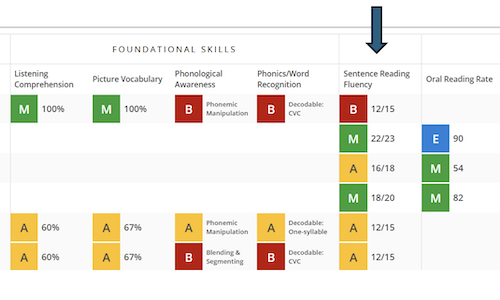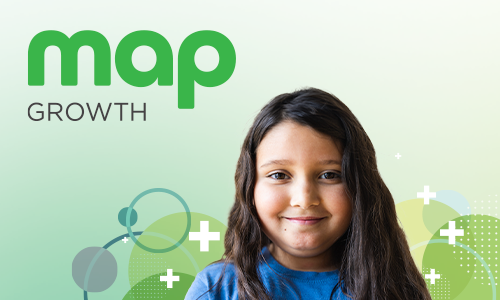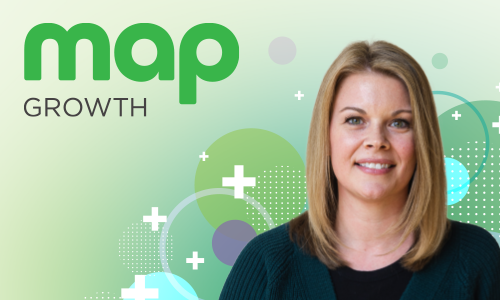
Please let me be clear: I am an almost five-foot-two musical theater kid who teaches math. The one sport I watch is soccer (#GoTimbers). Yet here I am, using baseball to sound cool make sense.
My goal? To better understand the learning continuum, a digital tool that helps teachers make sense of how their students did on MAP® Growth™. Before I get into that, let me remind you of a few things about MAP Growth:
- MAP Growth is an interim assessment that asks students around 43 questions from a much larger pool (usually thousands) of questions.
- The computer-adaptive test keeps adjusting the difficulty of questions based on whether a student answers a question correctly. If they get a question right, their next question will be a bit harder. If they get the question wrong, the next one will be easier.
- The goal of the assessment is to approximate a student’s zone of proximal development (ZPD), the sweet spot of just-the-right-amount-of-challenge that motivates kids to keep learning. Think of it as a perfect Jedi middle.
- Because the goal is to identify each student’s ZPD, kids can’t get all the questions on MAP Growth right. Students will answer test questions correctly about 50% of the time.
Now about that learning continuum…
What the learning continuum is—and isn’t
The learning continuum is the best way to understand what kinds of skills are assessed by MAP Growth test questions that fall within a 10-point RIT band. (A RIT is the score each student gets on the assessment. You can read more about it in “12 common questions parents ask about MAP Growth” and “How the MAP Growth RIT scale offers valuable insights into student growth.”)
Each 10-point RIT band has a long list of learning statements, occasionally upward of a few hundred. Learning statements speak generally about the type of test questions a group of students with similar RIT scores got right about 50% of the time. While the statements won’t provide specific details on what a particular student knows, they’re a useful place to begin your formative assessment from.
The most important thing to remember is this: the learning continuum is just a place to start. It’s not meant to replace a teacher’s expertise, and it’s certainly not meant to work as a lone data point, separate from formative assessment and other information you know about your students. More on that after our metaphor.
How the learning continuum is like baseball
Let me walk you through the metaphor that has helped me better understand how the learning continuum helps educators. Here’s a cheat sheet:
- Teachers = Coaches
- Students = Baseball players
- RIT scores = Previous leagues the players played in
Imagine you are the coach on a brand-new baseball team. Your new players come from all kinds of other minor league teams, ranging from AAA (the highest level of minor leagues) all the way to rookie league (the entry-level league). These leagues have reputations. The rookie league is known for having talent in certain areas but also for having players who haven’t fully rounded out their skill set. Meanwhile, the AAA league is known for having players who are almost ready for the major leagues and are ready to perfect their game.
On your first day as a coach, knowing what league each of these players came from helps you save time because it helps you ask smarter questions about each player and assign each one drills where you can begin the real work: assessing their specific skillsets.
The literal students in your classroom typically have a RIT score around 210, but you also have some students far above and far below that number. You know the learning statements in each 10-point band speak generally about the type of test questions a group of students with similar RIT scores got right about 50% of the time.
You take a look at the learning statements associated with each RIT score band in your class. You use the learning continuum as a starting point to develop your formative assessment plan, which will help you move from the generalities of what the assessment data tells you to the specifics of who each student is.
After contemplating the level of complexity you want to evaluate and applying your professional expertise, you develop the best questions to ask individual students that will identify their individual needs. Having this starting point saves you time by enabling you to ask more targeted questions and avoid having to start your formative assessment from scratch. What once was a classroom of RIT scores has now been transformed into a time-saving, data-informed formative assessment plan that launches the real teacher magic: evaluating each student’s specific skillset.
That’s a lot of metaphor! Let’s see it side-by-side to bring it home. (Get it? Home base?)
Where this metaphor gets sticky
Even though knowing a student’s previous “league” is useful, keep in mind some distinctions:
- Don’t rely on RIT scores/learning statements to determine grouping. Just because kids got similar scores (i.e., came from similar baseball leagues) doesn’t mean that’s automatically who they should be grouped with for every learning activity. The specific alchemy of student groups should consider far more factors than just a RIT score. And remember to always aim for flexible grouping.
- RIT score learning statements aren’t a prescriptive or comprehensive list. If a student has a RIT score of 159 and your room is closer to a 210 average, that student doesn’t only need 159-level material. They should still participate in group exercises, work with challenging content expected of their grade level, be given instructional supports to help them work toward greater independence, and receive instruction on foundational skills that bolster learning areas that need attention.
The first day of practice
The learning continuum’s list of learning statements can answer many questions: Which league did the player come from? What foundational areas do I know, from reputation, I need to evaluate first? By answering these questions, the learning continuum helps you use your experience as a coach to establish a starting point, after which you can begin designing the type of practice those in your charge need to become the best player they can be.
The learning continuum can’t tell you that your pitcher can’t throw a curveball or that your player at first base should really play third. It doesn’t tell you how to structure your practice or what drills to work on, and it definitely doesn’t indicate that a certain player should skip what the rest of the team is doing. What the learning continuum can do is provide teachers a place to begin asking smart questions, saving them time and streamlining subsequent decisions.
Learning who our players are is a long process. But at least we know what our first practice can look like. Play ball!






